

Pacing - Setting Activity Goals
The information in this section fits most situations, but what you are going
through may be different. If the doctor or nurse tells you to do something else,
please follow what they say.
This chapter looks at the many ways you can identify what you would like to
achieve in your life, despite the pain, and how to plan in order to achieve your
goals.
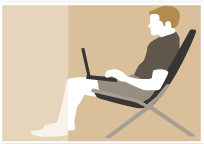

Goals

Learn


About how to pace yourself in activities
How to pace yourself in activities
Write down your goals and how you plan on pacing your activities
Read
Do

Goal
Complete the activity goals you have set
PACE - Picking a Problem
-
Introduction
It is time to do some detective work and pick a problem that you would like to work on. This is the first step of PACE!
What is pacing?
The goal of this chapter is to help you plan how to be more active in your
everyday life, despite having pain. The best way to do this is to pace your
activities.What does it mean to pace?
Pacing means to find a steady rate at which you can do activities and
achieve goals. Pacing can be used for a variety of activities, like chores,
hobbies, reading, walking, sitting, or even watching TV.The goal is to allow YOU to control your activities, and NOT let your pain control you!


I have a hard time narrowing down to one goal because there are so many things I would like to achieve



On a ‘bad day’ I can’t do anything but lie down and on a ‘good day’ I feel like I should do everything to catch up. This is overwhelming!
I can’t do nearly as much as I used to. I feel older than I actually am
I always thought that when a person feels pain, they should stop what they are doing or what they are doing or else it will get worse. But my doctor tells me to just keep going. I’m confused!
Lately, I don’t feel like doing anything outside of home; I even avoid visiting my friends


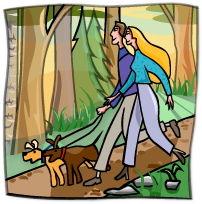
-
Activity cycling
People who have pain or other health problems often do two common things:
Avoiding activities and activity cycling can trap you into vicious cycles that can be hard to break out of. In this chapter you will learn ways to break these cycles. This will help you to have better control over your activities and not let your pain control them.
This vicious cycle of long term pain problems
This cycle needs to be broken
How to break the vicious cycle of long term pain problems
• Pace yourself
• Manage your stress
• Exercise and keep active
Remember that you are in control!
1. Base what they do and how much they do on how to they feel.
This is not good in the long term:
People often do more when they feel better. This can end up making their pain worse by overdoing it on good days.
We call this ACTIVTIY CYCLING
2. Avoid doing things they think will make them feel worse.
This is also not good in the long term:
It becomes more and more difficult to do things the longer you avoid them or put them off
Avoid things like visiting friends can make life more negative and gradually reduce self-confidence
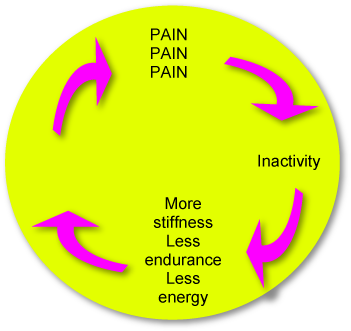
-
Reduced Activity
Naturally, when in pain, people feel that they should rest and reduce their activity levels. This is okay for acute pain, but NOT for chronic pain.
How is chronic pain different from acute pain?
Acute Pain
Reduced activity is okay because it allows the injured body part the necessary time to heal (like a sprained ankle, a muscle injury, etc). In these types of situations, the pain message is useful; it tells us to rest to avoid more problems
Chronic Pain
Reduced activity is not okay because the injured body part has already healed. Prolonged inactivity can cause even more problems. In this situation, the pain is no longer a useful message; it acts like a false alarm
-
Acute vs Chronic Pain
Important points
• Base what you do, and how much you do, on a plan – NOT on how you feel
• Carry out activities at a steady and regular pace – in a way that suites you
Goal setting and planning will help you to learn about yourself and what you CAN do.
Goal setting in a process which allows you to:
• Be in control of your activities
• Plan both what you do, and how much you do, at any one time
The skills of goal setting and planning needs practice in order to work!
Click on the video to learn more about goal setting
Certain goals can seem too big and hard to accomplish. In order to make them seem more management it is important to break them down into smaller goals. This will allow you to gain confidence as you achieve each goal in each step, and in turn accomplishing your long-term goals will seem easier.
Click on the video to view more comments about goal setting
Try your best to answer the following questions to help set your goal
1. What do I want to achieve? What is my ultimate goal?
2. How can I break this down so that I can make this more achievable? What is my intermediate goal?
3. What could be the first mini-goal towards my long term goal?
4. How long will it take to reach my ultimate goal?
Click on the icon to access a diagram that can help you to remember the steps involved in goal setting.
Click on the video to learn more about setting goals.


-
Myths and Facts
There are many common thoughts on pain and activity and it is not easy to know which ones are true and which ones are false.
You may have heard certain things about pain and activity or you could have made your own observations about it.
Please click on the icon below to view a list of common thoughts on pain and activity. Make sure to read whether each statement is true or false. You might be surprised about certain answers. It helps to look at the explanation box to see why that common thought turned out to be either true or false.

-
Statistics
Did you know?
49% of Canadians (aged 20 and over) are at least moderately active during their leisure time
60% of older adults are INACTIVE
Back pain is the most frequent cause of activity limitation in people younger than 45 years old
-
Quiz
Click on the video for a quick quiz about pacing
-
Example
Amanda picks a problem
On a bad day, I can hardly get out of bed and end up spending most of the
day sitting or lying down and nothing gets done. But on days when the pain is
less bad, I feel like it’s time to do all of the things I couldn’t do while in pain. I
end up doing too much and have to lay down for a couple of days just to
recuperate. I feel like I don’t have a life anymore because my pain is controlling
what I can and can’t do.

-
Worksheet
PACE - Acting Upon the Problem
-
Introduction
Now that you have picked a problem to work on, it’s time to decide what to do. Ready... set... action!
In this section, the second section of PACE, we will look at things you can do in your everyday life to help you be able to enjoy the activities you like to do.

-
Pacing Activity
As mentioned in the PACE section of this chapter, the goal of this
chapter is to help you plan how to be more active in your everyday life,
despite your pain. The best way to do this is to pace your activities.What does it mean to pace?
Pacing means to find a steady rate at which you can do activities and
achieve goals. Pacing can be used for a variety of activities, like chores,
hobbies, reading, walking, sitting, or even watching TV.The goal is to allow YOU to control your activities, and NOT let your pain
control you.When people suffer from pain for any length of time, their levels of activity become reduced. On a ‘good’ day, they try to catch up on all the things that they have not been able to do. On a ‘bad’ day, they may do very little or maybe do no activities at all. The result is often a vicious cycle of over-activity and under-activity (Activity Cycling). When this happens, PAIN CONTROLS ACTIVITY.
Click on the video to learn more about activity cycling

To prevent this from happening the answer lies in PACING. Pacing puts the person back in control of activity.
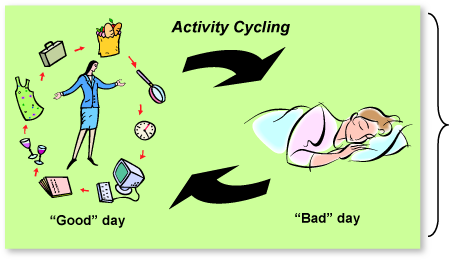
-
Making a pacing plan
You can manage your daily activities by PACING yourself!
• Pacing can help you manage what you do around the house,
at work, in your hobbies or your social life, without making
your pain worse• Pacing helps you to do regular amounts of activities EVERY
day, regardless if you are having a ‘good’ pain day or a ‘bad’
pain day• Pacing allows you to do activities based on a PLAN, not on how you FEEL
• Pacing will allow you to increase the amount of time you spend on activities using a planned method that is under your control
Managing your activity
Before starting a PACING plan you should think about some
activities that you find difficult to do. You can choose any activity
such as sitting, walking, standing, reading, vacuuming, or shopping.
By PACING yourself, you can learn to do your activity more often
and for longer.How do I make a pacing plan?
Pacing involves finding realistic times in which you can take part in
an activity. By setting time goals you can do your activities despite
your level of pain.You will start by doing your chosen activity for a short period of time.
Your pacing plan will allow you to slowly increase that time until you
reach your ultimate goal.Making a pacing plan
In the Picking a Problem section of this chapter we talked about goals.
An ultimate goal can be broken down into smaller goals. This concept
is helpful when making a pacing plan.For example, your goal might be to read a book:
• Ultimate goal: read the whole book
• Intermediate goal: read one chapter every month
• Mini goal: read 5 pages every day
You may feel discouraged or overwhelmed because you can’t sit for longer than 2 minutes at a time.
Pacing can help!
By making a pacing plan you can gradually sit for longer periods of time and reach your goal.
Pacing activity
In a pacing plan you will begin by doing your chosen activity for only a short amount of time, regardless of your pain level. You will gradually increase this time until you reach your ultimate goal.
Take the example of reading a book:
You may start by sitting for 1 minute at the very beginning of your plan. You will slowly increase the time until you reach your goal of reading 5 pages a day in one sitting.





-
Tolerances, baselines, and time levels

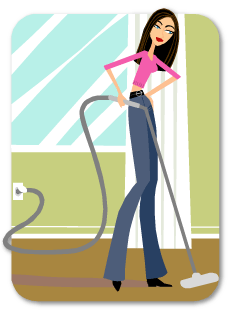
Making a PACING plan – Using tolerances, baselines, and time levels
Here are some terms we will use when learning about PACING
Tolerance
• The maximum length of time that you can do an activity until it becomes unbearable
Baseline
• The average tolerance of an activity divided in half
• This baseline time becomes the starting point of your PACING plan
Time Levels
• Your first time level of your plan will be your baseline time
• As you start to pace an activity, you will gradually increase your time level for that activity
• YOU decide when to increase your time level and by how much
1. Finding your tolerance level
The first thing to do when making a PACING plan is to calculate your
‘tolerance levels’ for your activity of choice.Your tolerance level is the maximum amount of time you can do an
activity until it becomes unbearable.Tolerance time
Make a list of your tolerance times for the activity of your choice. You will
need to take 4 times points. You time can be measured in minutes OR
seconds, not both.We suggest you take your tolerance times on a ‘typical’ pain day, not on a
day where you have no pain or are having an abnormally high amount of
pain.Tolerance time: Example 1
Here is an example using seconds to measure time:
Let’s say at 4 different times you found your tolerance time for vacuuming:
Time 1: 55 seconds
Time 2: 90 seconds
Time 3: 30 seconds
Time 4: 25 seconds
Add all the time together: 200 seconds
For this example, 200 seconds in your total tolerance time.Tolerance time: Example 2
Here is an example using time measured in minutes instead of seconds:
Let’s say at 4 different times you found your tolerance time for sitting:
Time 1: 5 minutes
Time 2: 3 minutes
Time 3: 4 minutes
Time 4: 4 minutes
Add all the times together: 16 minutes
This is your total tolerance time.2. Finding your Average Tolerance Time
We now need to find the AVERAGE of your tolerance times. Take your total tolerance time and divide it by the number of tolerance times you took (which should be 4).
From our example on the previous page, our total tolerance time was 16 minutes. To find the average we take 16 minutes and divide it by the number of tolerance times, which is 4.
= 16 minutes divided by 4 = 4 minutes
From our example, 4 minutes is the AVERAGE TOLERANCE time.
3. Finding your Baseline
To find the BASELINE time for your activity, you must now divide your average tolerance time in half.
For example we found that the average time for sitting was 4 minutes. We must now cut this time in half (divide it by 2) to find the baseline time.
= 4 minutes divided by 2 = 2 minutes
Our example baseline time is 2 minutes.
Here is a calculator you can use to determine your baseline time level. You must enter 4 tolerance levels. You can use minutes OR seconds, not both.
Now that you have found your activity baseline time, you can now think about making a PACING plan.Here’s how to begin
1. Use your baseline time level for your activity for at least the first 24 hours. DO NOT go over or under this time, REGARDLESS OF HOW GOOD OR BAD YOU FEEL! Stick to your baseline time no matter what your pain is like. It may be a good idea to set a timer.
Click on the video2. After 24 hours, assess how you coped with that time level
3. If this time level was not a problem, then increase the time. Try this new time for the next 24 hours
4. Keep increasing your time SLOWLY. Remember that you should try to stick to your time, no matter how good or bad your pain is
5. In order to test a time level you need to stick to it for a minimum of 24 hours
6. Continue to increase your time level in this way
The goal of pacing is not to increase or decrease your pain. So, while
you are pacing you may continue to have chronic pain and this may
or may not ever change. But by pacing your activities, you should be
able to increase the time you can carry out these activities, regardless
of your pain.Remember, it is important to stick to your pacing plan if you want to
achieve results. You should try to stick to your pacing times regardless
of how good or bad your pain is.Example – Walking to the store
Julianne’s baseline time for walking is 10 minutes. She would like to be able to walk to the grocery store that is 25 minutes away. Julianne plans to walk to the store and home again using pacing.
She could:
1. Walk for 5 minutes
2. Sit down and rest on a bench or lean against a wall for 2-3 minutes
3. Walk for 10 minutes
4. Sit on a bench or learn against a wall for 1-2 minutes
5. Walk 10 minutes to the shop
6. Stand outside the shop for 1 minute
7. Stand/walk inside the shop for 7 minutes
8. Rest outside the shop for 2-3 minutes on a wall or bench
9. Walk for 10 minutes on the way home (or less since carrying items)
10. Rest for 1 minute on a bench
11. Walk for 5 minutes
12. Rest – leaning against a wall
13. Walk 10 minutes to home
14. Rest 2-3 minutes
15. Unpack items purchased
Click on the icon to the right to access a TOLERANCE RECORD
SHEET where you can write down your tolerance levels for some
activities. This will help you calculate your average tolerance for each
activity.Click on the video to see an example about pacing activities.
Baseline Time Calculator





-
Prioritizing, planning, and pacing activity
Prioritizing
• What you do means choosing the most important things that need to be done
• Identify what needs to be done today (or this week) and what could wait until tomorrow or next week
• Asking yourself “does it have to be done at all?”
Planning
Once you have prioritized what has to be done, you then need to make a plan. Make sure that the activities you find more difficult are spread out, not done all in one go
Pacing
Stick to your time levels, even if you feel like doing more or don’t feel like doing anything
Click on the videos for examples on prioritizing and planning.
6 Point Activity Plan
1. Prioritize
2. Plan
3. Pace yourself and keep to the time levels that you have set
4. Change position according to your time levels
5. Think about doing things differently
6. Change your environment to make things easier
Handy tips on incorporating exercise into your everyday life
A healthy lifestyle is an active one. On top of your regular exercise you should also add in other activities into your everyday life. Take a look at the following tips to help you incorporate physical activity into your lifestyle.• Take the stairs instead of the elevator
• If you work in a large office, walk to talk to your colleagues instead of calling
them or sending them an email• If you use the bus, get off a stop or two earlier and walk
• Don’t worry about finding a parking stall next to the supermarket or mall entrance. By the time you have found a close parking stall you could have walked from a further, empty, and less stressful space!
• For small amounts of shopping or other errands use a bicycle instead of
the car, saving you money and the hassle or finding a parking stall. If you
live in a town, you will probably save time and if you live in the country
you can enjoy the countryside• If you have a cordless phone, or even a cell phone, walk and talk
Click on the video to learn about activities
Achievement DiaryClick on the icon to the right to access the Achievement Diary. This Diary is
helpful in keeping track of activities you did every day for one week.


-
Example
Amanda takes action
In the Setting Activity Goals chapter, I’ve read that it is necessary to pace
activities. I try to space out my activities on both good and bad days and to
be consistent with them. I filled out the goal setting sheet and I plan on
following my plan to pace myself in all my activities.

-
Worksheet
PACE - Challenges You May Face
-
Introduction
Even with the greatest plans we can sometimes come across obstacles. Before moving on with a plain, it is important to look at some of the challenges you may be facing. This brings us to the 3rd section of PACE.
Click to view video
-
I don't have time to do this!
It’s easier than you might think!
Click to view video.
When you pace yourself, you can achieve your goals step by step
and first thing you know... you’re doing it.It may take a little more time at first, just to reflect on your priorities and how to achieve them, but once you set up a plan and follow through, it just becomes a new lifestyle.
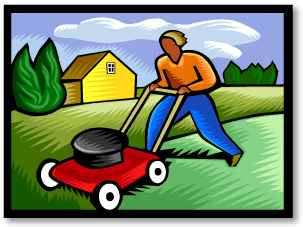
-
How to narrow down to one goal!
Remember to prioritize!
• Make a list of the things you would like to achieve
• Identify the activities that can’t wait from the ones that can
• Rewrite your list, putting the activities in order of priority
For example
• Buying groceries might be at the top of your list
• Washing the car might be near the end
When you put them in the order of importance, you assure that the things that
can’t wait will get done first. If there isn’t enough time to do everything in one day,
the things that can wait are simply left to be done on another day.
-
Example
Cindy evaluates her plan
“I’m glad that I asked for more help on the problems I was facing with sleep.
I used the advice I got on ways to help improve my sleep, and find that
wearing earplugs really blocks out the sound from my husband’s snoring,
which no longer interrupts my sleep. For the odd times that I struggle with
sleep, I now get up from bed and ready in the living room for a bit until I feel sleep, then return to bed. Ever since I have been doing this, I no longer feel the need to take long naps during the day. Whenever I feel the need for a nap, I now setup my alarm to assure that I don’t sleep longer than 20 minutes. I find that these techniques really work well!”Amanda gets more help
“I talked to my coach about finding it hard to pace my activities equally on
good and bad days. My coach explained that it is important to be consistent
with my activity level on both good and bad days, even if I feel like I could do
more on good days. My coach then said that when people do more than they
should on a good day, they could find themselves too exhausted to pace their
activities on bad days and it is important to break that activity cycle. A good way to break this cycle is by slowly increasing my energy and endurance, and when the time feels right, slowly increases the time level for each activity.”



-
Worksheet
Click on the book icon below to access the worksheet for this section. Remember, this worksheet is for your use only. If you would like advice or want to show these to a health professional, please feel free to bring a copy to your next appointment at the Pain Clinic.
For some challenges in your life you may need to call for help. You can click on the phone icon at the bottom left of the website to access help phone numbers.

PACE - Evaluating Your Plan
-
How did your plan work?
This brings us to the final step of PACE, evaluating your plan. Just like using a scale, weigh out how successful the plan was in dealing with the problem you picked to work on.
Reading about chronic pain and doing the activities required in this chapter may have brought up some concerns that you have in your life.
• Look at the concern you identified
• Did your plan work?
• Do you see some improvement?
• Look at the things that did work
Try not to fix everything all at once. Depending on the problem, some things may take longer to work than others.
Click on the video to learn more about evaluating your plan.


-
How will you know if you need to modify your plan?
For a week or two:
• Try to tack how well your plan is working
• At the end of every day, write down what is working and what isn’t
• Reward yourself for progress as often as you can
Remember that changing behaviours, especially when you are in pain or
feeling tired and stressful, can be difficult. If you persist, you will see positive results!
-
Different ways of keeping up with your plan in your everyday life

Good job, for getting this far! Now that you have done all the steps
necessary to work on the problem you picked to work on, it is
important to find ways of applying them in your everyday life.Asking your support network, like your friends and family, to help
motivate you with your plan is also a great idea.
-
Example
Amanda evaluates her plan
I’m glad that I talked to my coach because I now understand the importance
of pacing my activities equally on good and bad days. Keeping that in mind, I
think my plan to pace my activities will go well.

-
Worksheet
Click on the book icon below to access the worksheets for this section. NOTE: All the worksheets, checklists, diaries, and pain scales inserted in the chapters are for your use only. If you would like advice or want to show these to a health professional, please feel free to bring a copy to your next appointment at the Pain Clinic.

-
Example 2
How Amanda will stay on track
“I think that the best way for me to stay on track with my plan is by
consistently pacing my activities, on good and bad days. This may be hard
at first, but I will keep in mind that this is the best way to accomplish my
activity goals. I will also only increase my time level when I feel that I have
more energy and endurance. I plan on rewarding myself by doing a
crossword puzzle (which I really enjoy) for every activity goal I have
successfully accomplished.”

-
Worksheet

Checklist
The purpose of the chapter checklist is to give you the opportunity to express any additional concerns you might have that may not have been covered in the chapter reading material or worksheets.
The checklists are for your use only, however, should you feel the need to discuss any of your responses, please bring a copy to your next Pain Clinic Appointment.
If you are experiencing a high amount of distress, please click on the help phone icon the bottom left of the website.
Click on the icon to access the checklist
Resources
If you are interested in learning more about the subjects discussed in this chapter, please click on the icon to the right to access some references.
If you need help finding any of these resources you can ask any member your psychosocial team.
Physical activity guides
• www.phac-aspc.gc.ca/pau-uap/paguide/index.html
• www.phac-aspc.gc.ca/pau-uap/paguide/older/why.html
Statistics on physical activity
• www.cflri.ca/eng/statistics/index/php
• www.phac-aspc.gc.ca/pau-uap/paguide/older/why.html
Tips on being more active
Conclusion
Congratulations! You are done this chapter. By finishing this chapter and completing all the worksheets you have learned many skills. We hope that you have solved your problem using PACE and learned many new ways to tackle problems that you may have in the future. You have put in a lot of work in this chapter so give yourself a pat on the back.
In this chapter you have read about
• Setting goals
• The importance of pacing activities on good and bad pain days
• The difference between acute and chronic pain
• How to find your tolerances, baselines and time levels for various activities
• Ways to follow through with your activities
Clicking the next button will bring you to the table of contents for the chapter about ‘Mood’. Or if you prefer, you can choose a different chapter from the menu to the left.

Introduction
Goals
P - Picking a Problem
A - Acting Upon the Problem
C - Challenges You May Face
E - Evaluating Your Plan
Checklist
Resources
Conclusion
Glossary

















